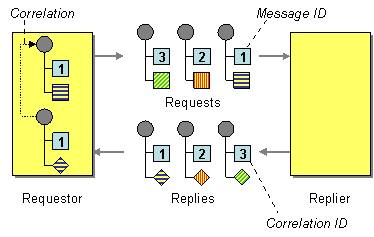Correlation Identifier
Camel supports the Correlation Identifier from the EIP patterns by getting or setting a header on a Message.
When working with the ActiveMQ or JMS components the correlation identifier header is called JMSCorrelationID. You can add your own correlation identifier to any message exchange to help correlate messages together to a single conversation (or business process).

The use of a Correlation Identifier is key to working with the Camel Business Activity Monitoring Framework and can also be highly useful when testing with simulation or canned data such as with the Mock testing framework
Some EIP patterns will spin off a sub message, and in
those cases, Camel will add a correlation id on the
Exchange as a property with they key
Exchange.CORRELATION_ID, which links back to the source
Exchange. For example the
Splitter, Multicast,
Recipient List, and Wire
Tap EIP does this.
The following example demonstrates using the Camel JMSMessageID as the Correlation Identifier within a request/reply pattern in the JMS component